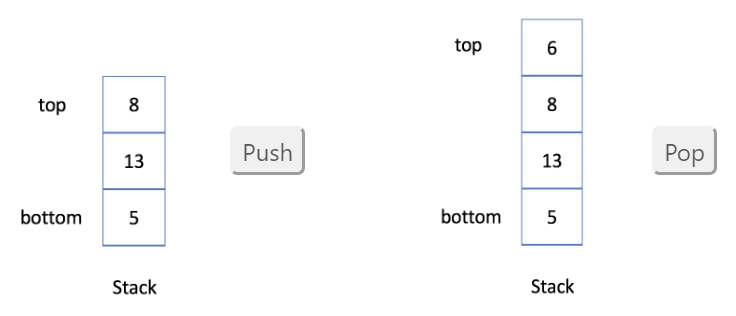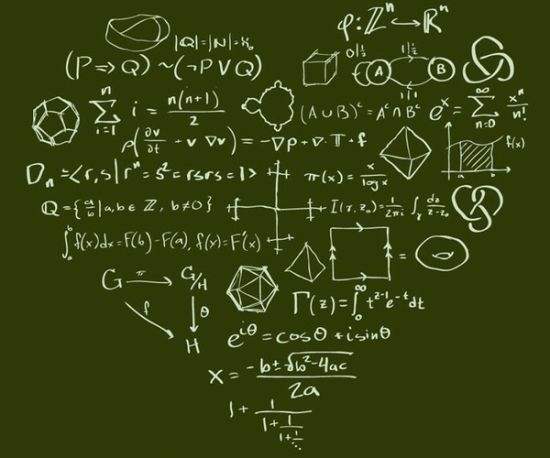leetcode探索之队列 & 栈学习 栈:后入先出的数据结构
作者:whisper
链接:http://proprogrammar.com:443/article/594
声明:请尊重原作者的劳动,如需转载请注明出处
本章节中,我们将介绍另一种处理顺序后入先出(LIFO),以及相应的数据结构,栈。
完成本章节后,你将:
- 理解 LIFO 和 栈的定义;
- 能够用动态数组实现栈;
- 熟悉内置栈结构;
- 能够使用栈解决问题。
后入先出的数据结构
在 LIFO 数据结构中,将首先处理添加到队列中的最新元素。
与队列不同,栈是一个 LIFO 数据结构。通常,插入操作在栈中被称作入栈 push 。与队列类似,总是在堆栈的末尾添加一个新元素。但是,删除操作,退栈 pop ,将始终删除队列中相对于它的最后一个元素。
示例 - 栈
1. 入栈:你可以单击下面的 Push 按钮查看如何将新元素 6 添加到栈中。
2. 退栈:你可以单击下面的 Pop 按钮查看当你从栈中弹出一个元素时将移除哪个元素。

实现 - 栈
栈的实现比队列容易。动态数组足以实现堆栈结构。这里我们提供了一个简单的实现供你参考:
// "static void main" must be defined in a public class.
class MyStack {
private List<Integer> data; // store elements
public MyStack() {
data = new ArrayList<>();
}
/** Insert an element into the stack. */
public void push(int x) {
data.add(x);
}
/** Checks whether the queue is empty or not. */
public boolean isEmpty() {
return data.isEmpty();
}
/** Get the top item from the queue. */
public int top() {
return data.get(data.size() - 1);
}
/** Delete an element from the queue. Return true if the operation is successful. */
public boolean pop() {
if (isEmpty()) {
return false;
}
data.remove(data.size() - 1);
return true;
}
};
public class Main {
public static void main(String[] args) {
MyStack s = new MyStack();
s.push(1);
s.push(2);
s.push(3);
for (int i = 0; i < 4; ++i) {
if (!s.isEmpty()) {
System.out.println(s.top());
}
System.out.println(s.pop());
}
}
}栈 - 用法
大多数流行的语言都提供了内置的栈库,因此你不必重新发明轮子。除了初始化,我们还需要知道如何使用两个最重要的操作:入栈和退栈。除此之外,你应该能够从栈中获得顶部元素。下面是一些供你参考的代码示例:
// "static void main" must be defined in a public class.
public class Main {
public static void main(String[] args) {
// 1. Initialize a stack.
Stack<Integer> s = new Stack<>();
// 2. Push new element.
s.push(5);
s.push(13);
s.push(8);
s.push(6);
// 3. Check if stack is empty.
if (s.empty() == true) {
System.out.println("Stack is empty!");
return;
}
// 4. Pop an element.
s.pop();
// 5. Get the top element.
System.out.println("The top element is: " + s.peek());
// 6. Get the size of the stack.
System.out.println("The size is: " + s.size());
}
}从现在开始,我们可以使用内置的栈库来更方便地解决问题。 让我们从一个有趣的问题(最小栈)开始,帮助你复习有用的操作。 然后我们将看一些经典的栈问题。 当你想首先处理最后一个元素时,栈将是最合适的数据结构。
算法-最小栈
设计一个支持 push,pop,top 操作,并能在常数时间内检索到最小元素的栈。
- push(x) -- 将元素 x 推入栈中。
- pop() -- 删除栈顶的元素。
- top() -- 获取栈顶元素。
- getMin() -- 检索栈中的最小元素。
示例:
MinStack minStack = new MinStack(); minStack.push(-2); minStack.push(0); minStack.push(-3); minStack.getMin(); --> 返回 -3. minStack.pop(); minStack.top(); --> 返回 0. minStack.getMin(); --> 返回 -2.
class MinStack {
private final int MAXSIZE = 1000;
private int[] data;
private int length;
private int min;
/** initialize your data structure here. */
public MinStack() {
data = new int[MAXSIZE];
length = 0;
min = Integer.MAX_VALUE;
}
public void push(int x) {
if(length < MAXSIZE){
data[length++] = x;
if(x < min){
min = x;
}
}
}
public void pop() {
if(length > 0){
int val = top();
if(val == min){
min = Integer.MAX_VALUE;
if(length > 1){
for(int i = 0; i < length - 1; i++){
if(data[i] < min){
min = data[i];
}
}
}
}
length--;
}
}
public int top() {
if(length > 0){
return data[length - 1];
}
return 0;
}
public int getMin() {
return min;
}
}与一般的栈不同的是可以获取最小元素,数组data放数据,length指示元素数量,min指示最小值,MAXSIZE是最大元素数量,定义的变量较多,多的好处是效率高些,多消耗一些空间,带来一些时间上的提升。
再看另一种实现
//第二个方法,运用更改单链表的方法,在节点中加了一个属性 当前最小值min。
class MinStack {
Node head;
/** initialize your data structure here. */
public MinStack() {
}
public void push(int x) {
if(head==null){
head = new Node(x,x);
}else{
int m;
m = x<head.min?x:head.min;
Node n = new Node(x,m);
n.next = head;
head = n;
}
}
public void pop() {
if(head!=null){
head = head.next;
}
}
public int top() {
return head.value;
}
public int getMin() {
return head.min;
}
}
class Node{
int value;
int min;
Node next;//后继节点
public Node(int value,int min){
this.value = value;
this.min=min;
next=null;
}
}这里使用链表实现,结点中的min表征从头结点到当前结点中的最小值,而不用像上面的方法循环查找最小值,提高了效率
算法-有效的括号
给定一个只包括 '(',')','{','}','[',']' 的字符串,判断字符串是否有效。
有效字符串需满足:
- 左括号必须用相同类型的右括号闭合。
- 左括号必须以正确的顺序闭合。
注意空字符串可被认为是有效字符串。
示例 1:
输入: "()" 输出: true示例 2:
输入: "()[]{}" 输出: true示例 3:
输入: "(]" 输出: false示例 4:输入: "([)]" 输出: false示例 5:
输入: "{[]}" 输出: true
class Solution {
// 想法:数据结构基本题,遇左括号入栈,遇右括号出栈,看是否匹配,字符串结束时栈要为空
public boolean isValid(String s) {
if(s.length() == 0){
return true;
}
char[] arr = s.toCharArray();
Deque<Character> stack = new ArrayDeque<>();
char temp;
for(char c: arr){
if(c == '}' || c == ']' || c == ')'){
if(stack.isEmpty()){
return false;
}else{
temp = stack.pop();
if(temp + 1 != c && temp + 2 != c){
return false;
}
}
}else{
stack.push(c);
}
}
return stack.isEmpty();
}
}括号匹配常会用到栈,解释在代码注释里
下面看一个效率更高的算法
class Solution {
public boolean isValid(String s) {
char [] t = new char [s.length()+1];
int p = 1;
for(char c:s.toCharArray())
{
if(c == '(' || c == '[' || c == '{')
t[p++] = c;
else
{
--p;
if(
(c == ')' && t[p] != '(')
||
(c == ']' && t[p] != '[')
||
(c == '}' && t[p] != '{')
)
return false;
}
}
return p == 1;
}
}提高效率的方法是自己用数组实现栈
算法-每日温度
根据每日 气温 列表,请重新生成一个列表,对应位置的输入是你需要再等待多久温度才会升高超过该日的天数。如果之后都不会升高,请在该位置用 0 来代替。
例如,给定一个列表 temperatures = [73, 74, 75, 71, 69, 72, 76, 73],你的输出应该是 [1, 1, 4, 2, 1, 1, 0, 0]。
提示:气温 列表长度的范围是 [1, 30000]。每个气温的值的均为华氏度,都是在 [30, 100] 范围内的整数。
class Solution {
// 想法:找到后面比它大的,记录距离,没有记0
public int[] dailyTemperatures(int[] T) {
int j, sum;
int[] result = new int[T.length];
continueLoop:
for(int i = 0; i < T.length - 1; i++){
sum = 1;
j = i + 1;
while(j < T.length){
if(T[i] >= T[j]){
sum++;
}else{
result[i] = sum;
continue continueLoop;
}
j++;
}
result[i] = 0;
}
return result;
}
}简单的使用二重循环来做的,下面看一种效率更高的做法
*用栈的常规做法
class Solution {
public int[] dailyTemperatures(int[] T) {
int len = T.length;
int[] res= new int[len];
Stack<Integer> stack = new Stack<>();
for(int i=len-1;i>=0;i--)
{ while(!stack.isEmpty() && T[stack.peek()]<=T[i])
{ stack.pop();}
if(stack.isEmpty()){ res[i]=0;}
else{ res[i]= stack.peek()-i;}
stack.push(i);
}
return res;
}
}这里使用了栈,数组从后向前的顺序入栈,对数组中第i个元素,栈中的元素是在i之后比第i个元素大且依次增大的
再看一种解法
class Solution {//类dp做法
public int[] dailyTemperatures(int[] T) {
int len = T.length;
int[] res= new int[len];
int max_til_now = T[len-1];//最高温
for(int i=len-2;i>=0;i--)//倒数第二天开始 最后一天必定是0
{ if(T[i]<T[i+1]){res[i]=1;}//小于后一天 那就是1
else//大于前一天 就看看前一天的将来升温时刻
{ if(T[i]>=max_til_now){ res[i]=0; max_til_now=T[i];}//高于最高温直接结束
else
{ int pre = i+1;//往前循环找前一天的升温时刻 往前跳转
while( T[ pre+res[pre]] <= T[i] )
{ pre = pre+res[pre];}//前一天的 升温时刻那天的 升温时刻
res[i] = pre+res[pre]-i;
}
}
}
return res;
}
}这里主要的思想是利用已有的部分结果,如果当前cur比后一个next高,那么要找比后一个更高的气温日期,哪个比后一个高呢,next后第res[next]是求得的比next高的,那天的气温是T[next+res[next]],T[cur]与T[next+res[next]]比较,不满足的化T[cur]与比next+res[next]高的那天比较,重复此过程(这中间考虑最高温的情况,如果不比最高温低,直接为0)
算法-逆波兰表达式求值
根据逆波兰表示法,求表达式的值。
有效的运算符包括 +, -, *, / 。每个运算对象可以是整数,也可以是另一个逆波兰表达式。
说明:
- 整数除法只保留整数部分。
- 给定逆波兰表达式总是有效的。换句话说,表达式总会得出有效数值且不存在除数为 0 的情况。
示例 1:
输入: ["2", "1", "+", "3", "*"] 输出: 9 解释: ((2 + 1) * 3) = 9示例 2:
输入: ["4", "13", "5", "/", "+"] 输出: 6 解释: (4 + (13 / 5)) = 6示例 3:
输入: ["10", "6", "9", "3", "+", "-11", "*", "/", "*", "17", "+", "5", "+"] 输出: 22 解释: ((10 * (6 / ((9 + 3) * -11))) + 17) + 5 = ((10 * (6 / (12 * -11))) + 17) + 5 = ((10 * (6 / -132)) + 17) + 5 = ((10 * 0) + 17) + 5 = (0 + 17) + 5 = 17 + 5 = 22
class Solution {
// 数据结构基本题:遇数入栈,遇操作符出栈,计算结果入栈
public int evalRPN(String[] tokens) {
Deque<Integer> stack = new ArrayDeque<>();
List<String> op = Arrays.asList("+", "-", "*", "/");
int num1, num2;
for(String token: tokens){
if(op.contains(token)){
num2 = stack.pop();
num1 = stack.pop();
if("+".equals(token)){
stack.push(num1 + num2);
}else if("-".equals(token)){
stack.push(num1 - num2);
}else if("*".equals(token)){
stack.push(num1 * num2);
}else{
stack.push(num1 / num2);
}
}else{
stack.push(Integer.parseInt(token));
}
}
return stack.pop();
}
}栈的基本题,遇操作数入栈,遇操作符出栈两个操作数,计算,结果入栈,可以自己实现栈以提高效率,就不多说了
亲爱的读者:有时间可以点赞评论一下
作者其它文章
- 数字图像处理
- 剑指offer2
- 工作学习
- 这些算法有自己的方法
- 插件
- 软件使用
- 数学
- mybatis
- 计算机网络
- 正则表达式专栏
- 问题记录
- Thymeleaf
- zuul
- hystrix
- 正则表达式
- feign
- 编程相关技术
- ribbon
- 微服务
- eureka
- 分布式
- 模板
- angularjs
- javascript
- html
- c++ grammar
- c grammar
- python grammar
- java grammar
- 软件工程
- 数据库系统概论
- 转载
- 小知识
- 考研
- webservice
- 网络
- struts2
- springmvc
- springboot
- redis
- mongodb
- hibernate
- 计算机组成原理
- 当代世界经济与政治
- leetcode
- 思想道德修养与法律基础
- 毛泽东思想和中国特色社会主义理论体系概论
- 作乐
- 生活点滴
- 娱乐
- 中国近现代史纲要
- 操作系统
- sunny day, singing day
- 设计模式与算法
- 框架
- 概率论与数理统计
- 线性代数
- JAVA
- 前端
- 数据库
- 马克思主义基本原理概论
- 软考
- 生活,生,活
- 晴雨
- CSS
- LINUX
- java web整合开发王者归来
- 英语
- 高等数学
- 数据结构



















全部评论